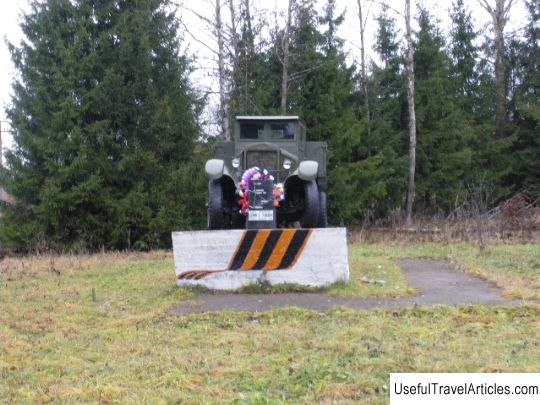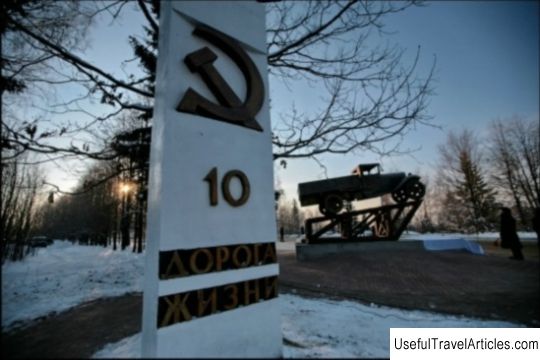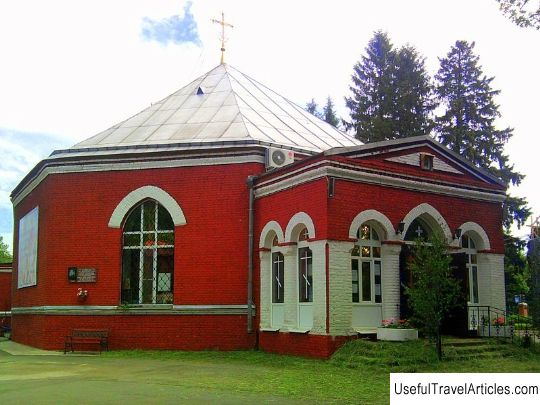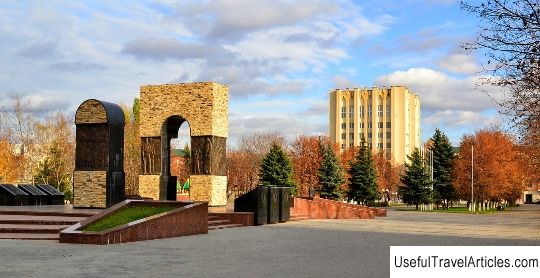Memorial complex ”Flower of Life” description and photo - Russia - Leningrad region: Vsevolozhsky district
Rating: 8,2/10 (1243 votes) 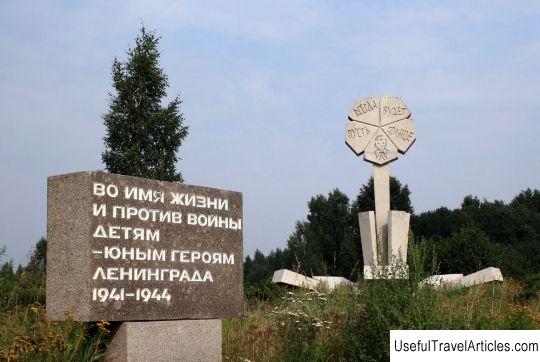
Memorial complex "Flower of Life" description and photo - Russia - Leningrad region: Vsevolozhsky district. Detailed information about the attraction. Description, photos and a map showing the nearest significant objects. Photo and descriptionIn the Leningrad region, not far from Vsevolzhsk, at 3 kilometer of the Road of Life, there is a memorial complex, opened in 1968, called "The Flower of Life". It is dedicated to the children who died in besieged Leningrad. The monument is a complex consisting of three parts: a 15-meter flower made by sculptor P. Melnikov, Friendship Alley (designed by architect A. Levenkov) and a mound with eight stele-pages symbolizing entries from the notebook-notebook of Tanya Savicheva (architects M. Koman, G. Fetisov, A. Levenkov). The petals of a stone chamomile depict the face of a boy who smiles, and words from a children's song "May there always be sun." Nearby there is a plate on which is written “In the name of life and against war. To Children - Young Heroes of Leningrad 1941-1944 ”. "Flower" was opened in 1968. 900 birches grow around the monument, one tree, symbolizing every day of the blockade. In January days, you can still see scarlet ties on the birches. The Friendship Alley connects the Flower of Life and the mourning mound. On the steles, which are located along the alley, it tells about the heroism of the children-defenders of Leningrad. Here the names of the pioneers - Heroes of the USSR and holders of high state awards and the deeds accomplished by them are immortalized. Particular attention is drawn to the "pages" from the diary of Tanya Savicheva. This diary became a symbol of the Leningrad blockade. This miniature notebook was presented at the Nuremberg trials as a document that accuses fascism. Tanya Savicheva was born on January 23, 1930. In the days of the siege, she wrote down the dates and times of death of her relatives in a notebook she inherited from her sister Nina. Tanya was born into the family of Nikolai Rodionovich and Maria Ignatievna Savichev. During the NEP years, Tanya's father owned a private artel, in which his wife and brothers Alexei, Vasily and Dmitry worked. Tanya was the youngest child. She had older sisters Zhenya and Nina and brothers Leonid and Misha. With the NEP ban, the family was expelled from the city. Some time later, Nikolai Radionovich died. Later, the widow and children were allowed to return to Leningrad. Maria Ignatievna was a seamstress. By the beginning of the war, the older sisters and brothers of Tanya occupied simple working positions, the sisters worked at the machine-building plant. Lenin, Leonid (Leka) mastered the profession of a planer in ship mechanical production, Misha worked as an assembly fitter. By 1941, the Savichev family - mother, grandmother Evdokia Grigorievna Fedorova, children - lived on Vasilievsky Island. The brothers of Tanya's father, Vasily and Alexei, lived in the same house, one floor above. Dmitry died before the war. Zhenya was already married and lived on Mokhovaya. Relations between the spouses did not work out, but she did not return home. Tanya moved to the 4th grade of school number 35 on the current Cadet line. When the war was announced, the Savichev family decided to stay in the city. Leonid, due to poor eyesight, received a white ticket and continued to work at the plant. Uncle Vasily, with whom Tanya was especially friendly, tried to volunteer in the people's militia, but he was refused because of his age - he was 71 years old. Sister Nina, together with her colleagues, dug trenches in Kolpino, Rybatsky, Shushary, was on duty at the air observation post. In secret from the household, Zhenya donated blood. Maria Ignatievna sewed military uniforms. Tanya, together with other children, cleaned attics, collected glassware for incendiary bottles. Misha, before the announcement of the beginning of the war, was outside the city. He did not make himself known and was considered dead. He survived, fought in a partisan detachment. Zhenya was the first to die at the age of 32. Since the transport did not work, she walked 7 km to work every day. She worked in 2 shifts. She died at work. Then Tanya made the first mournful line in her notebook: "Zhenya died on December 28 at 12.30 am in 1941" In January, her grandmother Evdokia was diagnosed with the third degree of alimentary dystrophy. She died 2 days after Tanya's birthday. A new entry appeared in the notebook: “My grandmother died on January 25. 3 pm 1942 " One day in February 1942, Nina did not return home. This coincided with the shelling, and she was presumed dead. Nina came under urgent evacuation along with the plant where she worked. She could not give the news home. Nina survived. Leonid actually lived at the plant. He worked day and night. He came home very rarely. He died at 24 from dystrophy in a factory hospital. In her notebook, Tanya wrote: "Lyoka died on March 17 at 5 o'clock in the morning in 1942" Tanya's beloved uncle, Vasily, passed away next in the family. An entry appeared in the diary: "Uncle Vasya died on April 13, 2:00 am, 1942." Uncle Alexei died at 71 from third-degree nutritional dystrophy. Tanya will write in her diary: "Uncle Lesha on May 10 at 4 pm 1942". 3 days after that, Maria Ignatievna died. Tanya will write: "Mom on May 13 at 7.30 am 1942." Further in the diary she made the last three entries, ending the diary with the words: "... everyone died ...". At first, Tanya was helped by neighbors, then she went to a relative of her grandmother - Aunt Dusya, who later sent her with the orphanage to evacuate. Tanya died at the age of 14 from progressive dystrophy, scurvy, bone tuberculosis and intestinal tuberculosis in the infectious diseases department of the Shatkovskaya regional hospital on the first day of July 1944       We also recommend reading Hot stone description and photo - Russia - North-West: Arkhangelsk region Topic: Memorial complex ”Flower of Life” description and photo - Russia - Leningrad region: Vsevolozhsky district. |

